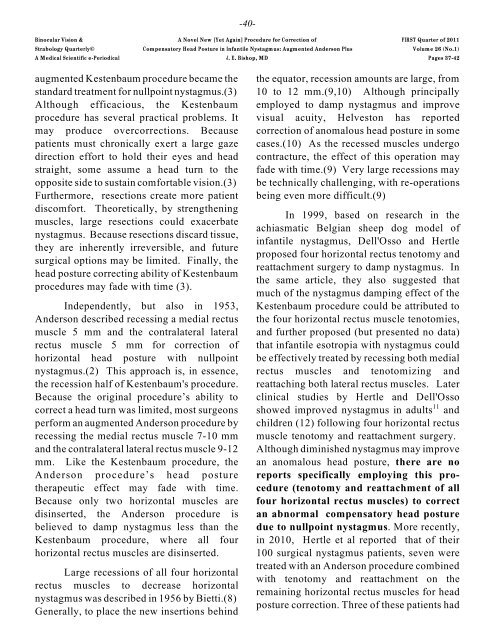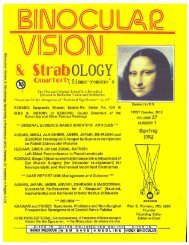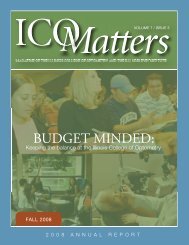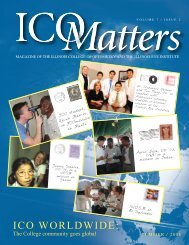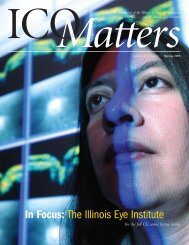Correspondence - ICO Library
Correspondence - ICO Library
Correspondence - ICO Library
You also want an ePaper? Increase the reach of your titles
YUMPU automatically turns print PDFs into web optimized ePapers that Google loves.
-40-<br />
Binocular Vision & A Novel New [Yet Again] Procedure for Correction of FIRST Quarter of 2011<br />
Strabology Quarterly© Com pensatory Head Posture in Infantile Nystagm us: Augm ented Anderson Plus Volum e 26 (No.1)<br />
A M edical Scientific e-Periodical J. E. Bishop, M D Pages 37-42<br />
augmented Kestenbaum procedure became the<br />
standard treatment for nullpoint nystagmus.(3)<br />
Although efficacious, the Kestenbaum<br />
procedure has several practical problems. It<br />
may produce overcorrections. Because<br />
patients must chronically exert a large gaze<br />
direction effort to hold their eyes and head<br />
straight, some assume a head turn to the<br />
opposite side to sustain comfortable vision.(3)<br />
Furthermore, resections create more patient<br />
discomfort. Theoretically, by strengthening<br />
muscles, large resections could exacerbate<br />
nystagmus. Because resections discard tissue,<br />
they are inherently irreversible, and future<br />
surgical options may be limited. Finally, the<br />
head posture correcting ability of Kestenbaum<br />
procedures may fade with time (3).<br />
Independently, but also in 1953,<br />
Anderson described recessing a medial rectus<br />
muscle 5 mm and the contralateral lateral<br />
rectus muscle 5 mm for correction of<br />
horizontal head posture with nullpoint<br />
nystagmus.(2) This approach is, in essence,<br />
the recession half of Kestenbaum's procedure.<br />
Because the original procedure’s ability to<br />
correct a head turn was limited, most surgeons<br />
perform an augmented Anderson procedure by<br />
recessing the medial rectus muscle 7-10 mm<br />
and the contralateral lateral rectus muscle 9-12<br />
mm. Like the Kestenbaum procedure, the<br />
Anderson procedure’s head posture<br />
therapeutic effect may fade with time.<br />
Because only two horizontal muscles are<br />
disinserted, the Anderson procedure is<br />
believed to damp nystagmus less than the<br />
Kestenbaum procedure, where all four<br />
horizontal rectus muscles are disinserted.<br />
Large recessions of all four horizontal<br />
rectus muscles to decrease horizontal<br />
nystagmus was described in 1956 by Bietti.(8)<br />
Generally, to place the new insertions behind<br />
the equator, recession amounts are large, from<br />
10 to 12 mm.(9,10) Although principally<br />
employed to damp nystagmus and improve<br />
visual acuity, Helveston has reported<br />
correction of anomalous head posture in some<br />
cases.(10) As the recessed muscles undergo<br />
contracture, the effect of this operation may<br />
fade with time.(9) Very large recessions may<br />
be technically challenging, with re-operations<br />
being even more difficult.(9)<br />
In 1999, based on research in the<br />
achiasmatic Belgian sheep dog model of<br />
infantile nystagmus, Dell'Osso and Hertle<br />
proposed four horizontal rectus tenotomy and<br />
reattachment surgery to damp nystagmus. In<br />
the same article, they also suggested that<br />
much of the nystagmus damping effect of the<br />
Kestenbaum procedure could be attributed to<br />
the four horizontal rectus muscle tenotomies,<br />
and further proposed (but presented no data)<br />
that infantile esotropia with nystagmus could<br />
be effectively treated by recessing both medial<br />
rectus muscles and tenotomizing and<br />
reattaching both lateral rectus muscles. Later<br />
clinical studies by Hertle and Dell'Osso<br />
11<br />
showed improved nystagmus in adults and<br />
children (12) following four horizontal rectus<br />
muscle tenotomy and reattachment surgery.<br />
Although diminished nystagmus may improve<br />
an anomalous head posture, there are no<br />
reports specifically employing this procedure<br />
(tenotomy and reattachment of all<br />
four horizontal rectus muscles) to correct<br />
an abnormal compensatory head posture<br />
due to nullpoint nystagmus. More recently,<br />
in 2010, Hertle et al reported that of their<br />
100 surgical nystagmus patients, seven were<br />
treated with an Anderson procedure combined<br />
with tenotomy and reattachment on the<br />
remaining horizontal rectus muscles for head<br />
posture correction. Three of these patients had


